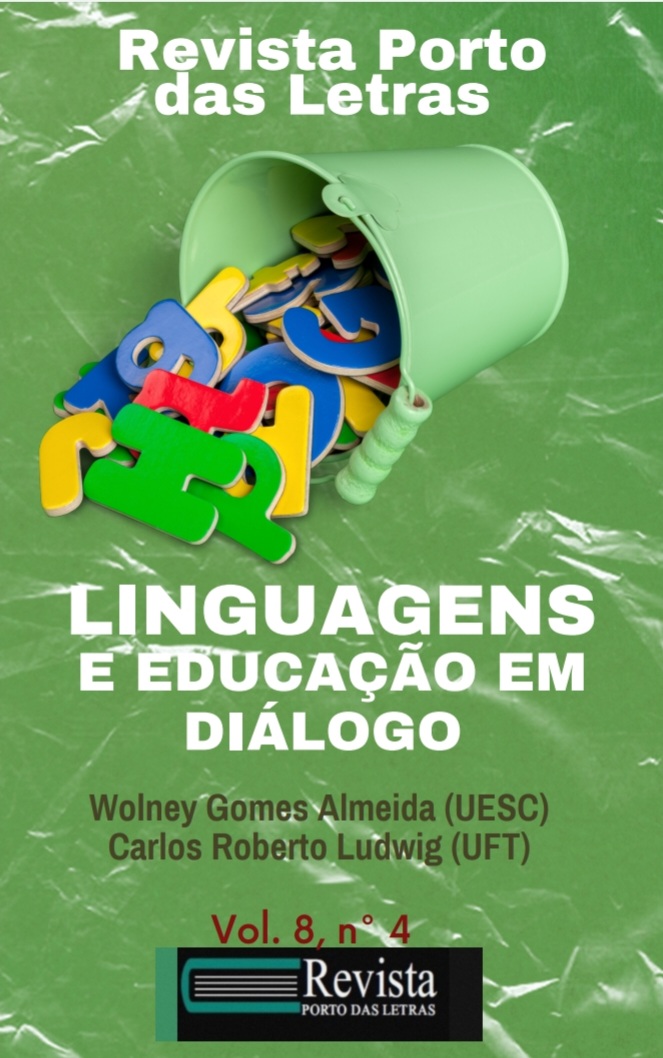VIDAS SECAS NA ZOOLITERATURA
UMA ANÁLISE DAS RELAÇÕES ENTRE O ANIMAL HUMANO E O NÃO-HUMANO NA OBRA DE GRACILIANO RAMOS
Abstract
In 1938, the writer Graciliano Ramos publishes the work entitled Vidas Secas which it fits into the regionalist prose of the second phase of Brazilian Modernism, highlighting the life of migrants and non-human animals in through long periods of drought. In this context, this research aims to investigate, under the method of Discourse Analysis of French Line and the Zoocritical perspective - which studies the overlaps between Literature and animals -, the relationships of the human animal with the non-human animal present in the work under examination, also dialoguing with the environment, society and culture, tracing, thus, representations of the sertanejo and of the sertão. Given the above, the speeches of the characters in the above work demonstrate the animality of the human in some moments of the narrative and, in others, the sentience of the non-human animal, more precisely of the "Whale dog", which presents evoked feelings and emotions literally. Therefore, Zoocritics constitutes an area of interdisciplinary and transdisciplinary research, providing a useful tool for understanding the relationships between humans and non-human animals in a holistic dynamic and, therefore, seeking an integral vision, bringing the whole closer to the parts and parts as a whole. In this direction, the present manuscript is launched as an important substrate in the interpretation of human-non-human-environment relations, which may awaken new perceptions and analyzes in light of this ebullient theme.
References
BORGES, Jorge Luís; GUERRERO, Margarita. Manual de zoologia fantástica. Fondo de Cultura Económica, México, 1966.
BOSI, Alfredo. História Concisa da Literatura Brasileira. São Paulo: Cultrix, 2006.
CANDIDO, Antonio. A Personagem de Ficção. São Paulo: Perspectiva, 2009.
COUTINHO, Afrânio. As formas da literatura brasileira. Rio de Janeiro: Bloch, 1984.
DARWIN, Charles. Descent of Man. Princeton: Princeton University Press, 1981.
DERRIDA, Jacques. O animal que logo sou. Tradução: Fábio Landa, São Paulo: Editora UNESP, 2002.
AYALA. Dizy. Nova Zelândia reconhece legalmente todos os animais como seres sencientes. 2020. Disponível em:http://acaopelosdireitosdosanimais.blogspot.com. Acesso em 30.05.2021.
FREUD, Sigmund. O Inconsciente. In: Sigmund Freud. Obras Completas. ESB, v. XIV, (1915a), cap. 7, p. 183 233.
FREUD, Sigmund. Os instintos e suas vicissitudes. In: Sigmund Freud. Obras Completas. ESB, v. XIV, (1915b), cap. 6, p. 129 162.
FREUD, Sigmund. O Mal-Estar na Civilização (1930). Rio de Janeiro: Imago, 1996.
GREEN, A. Narcisismo de vida. Narcisismo de morte. São Paulo: Escuta, 1988.
LESTEL, Dominique. As origens animais da cultura. 1. ed., São Paulo: Editora Instituto Piaget, 2002.
MACIEL, Maria Esther. O animal escrito: um olhar sobre a zooliteratura contemporânea. São Paulo: Lumme Editor, 2008.
MACIEL, Maria Esther. Exercícios de Zooliteratura. Revista ComCiência. Campinas-SP, n. 134, p. 1-4, jul., 2011.
MACIEL, Maria Esther. Literatura e animalidade. Rio de Janeiro: Civilização Brasileira, 2016.
MACIEL, Maria Esther. A Zooliteratura tem um enfoque multifacetado. Entrevista concedida a Gianni Paula de Melo. Revista Continente, 2016. Disponível em: https://www.academia.edu/21139805/Entrevista_sobre_zooliteratura_Revista_ContinenteAcesso em: 28.05.2021.
MONTAIGNE, Michel de. Apologia de Raymond Sebond. São Paulo: Abril Cultural, 1980.
ORLANDI, Eni Pulccinelli. Análise de discurso: princípios e procedimentos. Campinas, SP: Pontes/UNICAMP, 2012.
PATTO, M. H. S. O mundo coberto de penas, família e utopia em Vidas secas. Revista Estudos Avançados, São Paulo, v. 26, n. 76, p. 225-236, 2012.
PÊCHEUX, Michel. Les Vértiés de la Palice, Maspero, Paris, trad. bras. Semântica e Discurso, ORLANDI, Eni. Editora da UNICAMP, 1975.
RAMOS, Graciliano. Vidas Secas. Rio de Janeiro: Editora Record, 2013.
RIBEIRO, M. F. da R. Uma reflexão conceitual entre identificação projetiva e enactment. O analista implicado. Revista Cadernos de psicanálise. Rio de Janeiro, v. 38, n, 35, p. 1-18, dez., 2016.
ROSA, João Guimarães. Ave palavra. Rio de Janeiro: Editora Nova Fronteira, 2015.
WOHLLEBEN, Peter. A vida secreta dos animais. Rio de Janeiro: Sextante, 2019.
Downloads
Published
How to Cite
Issue
Section
License
Os autores concordam com os termos da Declaração de Direito Autoral, que se aplicará a esta submissão caso seja publicada nesta revista (comentários ao editor podem ser incluídos a seguir).

